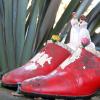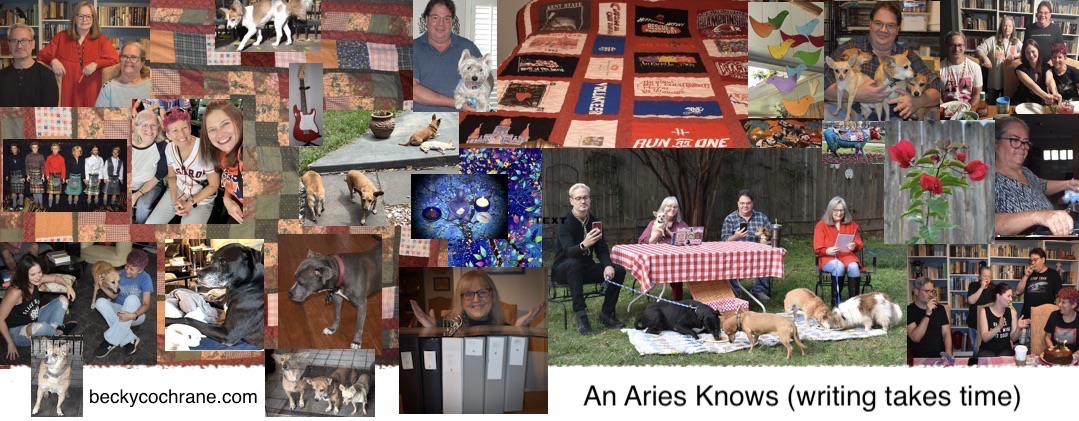Recently, I stumbled across this photo:

You can see the full-scale version of the image at this link from mybluemuse.com.
The photo made me want to research the Alamo Square Shoe Garden.
If the shoe fits, plant it
by Hazel White
Tourists who come to Alamo Square to photograph the Painted Ladies against the city skyline often take more photographs of an unexpected and mysterious “shoe garden” on one side of the gardeners’ shed in the middle of the park.
“The garden makes people laugh,” said David Clifton, the city gardener who made it. “A visitor from Atlanta, a teacher of horticulture, took photographs to show his class; he’d never seen anything like it. Sometimes I’m sitting inside the shed and I overhear people saying, “Come over here, you got to see this; it’s so crazy, so cool.’ ”
Clifton’s work as the gardener in charge of Alamo Square Park includes picking up the trash. He finds shoes. That’s how the garden started; he hated to throw the shoes out. To begin with, it was just fun to collect them, and then Clifton saw a chance to put the shoes to use. He arranged them on top of logs and placed the logs around a flower bed to keep dogs out. After that, though, he took another step, which led him into something writer John Beardsley calls “magical tinkering”: He planted the shoes with flowers.
Then the real fun began. “I’d find things at the door when I come in at 6 o’clock,” he said. “A lady drops off a pair of strapless high heels with a message that she wants the shoes to be part of my garden. Then she comes back and says she sees the shoes, but there’s no plants there.”
“I think I’ll put something in there,” he added, even though he wasn’t going to expand the garden until the recent work on the park irrigation is finished.
Clifton calls the garden “a reflection of the neighborhood.” There’s “really mixed stuff” in the garden: a red patent-leather baby shoe with a baby primrose in it, turquoise pumps planted with hen and chicks, a woman’s cowboy boots planted with onions and midnight blue pansies, two daisy sneakers with primroses, roller skates with tulips, a chair with a drawer of ranunculus, an action toy, a Japanese lantern, brick plugs from the foundation of an old Victorian mansion. Everying belonged to “really cool people in the neighborhood,” said Clifton, “gay, black, white, dog walkers, whomever.”
GOLD HIGH HEELS
One day a pair of sparkly gold high heels showed up. Clifton’s work partner,
Vicky Vierra, found them. Clifton, who is gay, laughed when he saw them; they were “so drag queen-like; they were size 12 or something, with really spiked heels. “Oh, God, we have a queer garden going on,’ I thought.”
Planted with grass, the gold shoes were a winner with the photographers and the neighborhood. Then, even though they had been nailed down, they disappeared. Clifton is still a little heartbroken. It’s fine with him when people rearrange the garden. He usually doesn’t get discouraged about the occasional losses, either. “I don’t get stressed. If I put a figurine out there, it may be that it goes, or it may be that someone adds something.”
People drop off plants for the garden – paper-white narcissus, a little evergreen tree, cineraria, primroses. Tumbleweed that Clifton roped up in the trees disappears, then more stuff is left on his doorstep.
Clifton witnesses people’s delight in his work, but he’s reluctant to talk about whether he is an artist in the tradition of folk art or environmental sculpture. He works with found materials, as many of those artists do; I think he has heartfelt ideas, a vision, about urban life and tolerance.
“I feel weird. Yeah, I am an artist, but I never thought about it like that, ” he says. The garden is popular in the neighborhood. Locals bring visitors here. Children run right to it. People sit around for a while on the seats Clifton has fashioned out of fallen trees and ask him how he gets his fences (made of live sycamore twigs) to grow.
Part of the pleasure of the garden is the excitement of finding someone else’s shoes filled with dirt and leaves, an implausible combination of intimate human object and vegetable matter.
But something larger is also at play. People respond to the beauty of the garden, even though it doesn’t have much about it that we’d usually call beautiful. When I press Clifton about whether his garden – in giving a new dignity to thrown-away stuff he has nursed back to life, in making something out of nothing, in creating a world where ordinary things are turned into gold – isn’t an expression of faith, he shies away from such talk.
“It’s a lot simpler than that,” he said, “I found this cute, nice stuff, and then it got to people enjoying it.” He’d welcome being an artist, but immediately he reminds me that he has a job and that he’s afraid of losing it in looming cutbacks.
copyright: San Francisco Chronicle, May 24, 2003

it must be “that time” because I got teary reading about the shoe garden
for some reason this makes me rather happy.
Thank you for your post and link!
It IS a special place and sadly it’s easy to overlook.
Thank goodness for digicams as I spent a couple hours there lost on macro mode composing shot after shot which I will post here and there on my blog. Here are two more that are up now, though, I do love the one you selected in particular:
Dorothy’s Shoes:
http://www.mybluemuse.com/pixelpost/index.php?showimage=42
Elvis Ryka:
http://www.mybluemuse.com/pixelpost/index.php?showimage=49
PJ Taylor
Mostly Sunny
P.S. Checked out your One Word Art and I will be in touch! Also, your author site. You ARE busy! Fantastic!